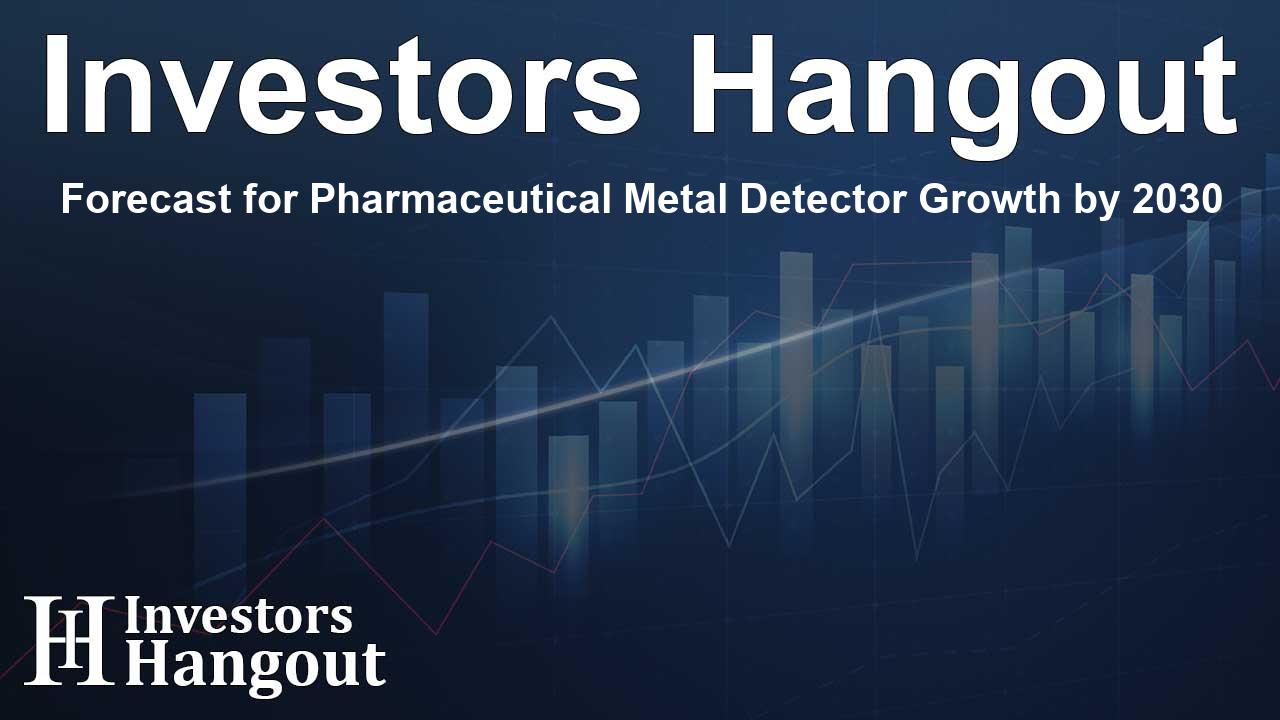Forecast for Pharmaceutical Metal Detector Growth by 2030

Pharmaceutical Metal Detectors: An Expanding Market
The global market for pharmaceutical metal detectors is poised for remarkable growth, projected to reach US$197.7 million by the end of the decade. This expansion is mainly attributed to stringent regulatory standards aimed at ensuring product safety, coupled with a rising demand for contamination-free pharmaceutical goods. As manufacturers face increasing pressure due to product recalls and quality control issues, the need for advanced detection technologies has never been more critical.
Market Drivers: Safety and Compliance
The Role of Advanced Detection Technologies
Compliance with industry standards like Good Manufacturing Practice (GMP) and Food and Drug Administration (FDA) regulations compels pharmaceutical companies to invest in sophisticated inspection equipment. Innovative detection systems that are automated and intelligent not only enhance operational efficiency but also reinforce the reliability of production processes. By leveraging cutting-edge sensor technologies and real-time monitoring capabilities, companies are better equipped to tackle the challenges of maintaining quality parameters.
Product Type Analysis
In terms of product types, tablet metal detectors have emerged as the leading segment within the pharmaceutical metal detectors market. Given that tablets are the most prevalent form of dosage, their production involves various mechanical processes that heighten the risk of metal contamination. To mitigate this risk, manufacturers deploy advanced tablet metal detectors, which feature high-precision sensors designed for rapid production without compromising on regulatory compliance.
Technological Innovations Driving Growth
Magnetic Field Detectors
Among the various detection technologies, magnetic field detectors stand out for their efficacy in meeting GMP and FDA compliance standards. This technology is particularly adept at detecting stainless steel contaminants, commonly found in production settings. Its affordability compared to more advanced systems like X-ray detectors makes it a popular choice, particularly in cost-sensitive environments. The balance of performance and economic viability secures magnetic field detectors as a favored solution in the market.
Regional Insights: North America's Market Leadership
North America plays a predominant role in the pharmaceutical metal detectors market, characterized by rigorous regulations and a robust pharmaceutical sector. With agencies such as the FDA and Health Canada imposing strict quality checks, the region sees extensive use of metal detection systems as a means to guarantee product safety. Automation and the adoption of Industry 4.0 practices are burgeoning trends that further drive the demand for reliable contamination detection systems. Frequent incidents of drug recalls also underscore the necessity for dependable detection technologies.
Key Players Shaping the Market Landscape
Leading companies in the pharmaceutical metal detectors market include Mettler-Toledo International Inc., Thermo Fisher Scientific Inc., and Anritsu Corporation, among others. Each of these firms brings unique strengths to the table. For instance, Mettler-Toledo's Safeline product line is noted for its high sensitivity and revolutionary capabilities in detecting contaminants across various pharmaceutical forms. In contrast, Thermo Fisher Scientific’s APEX 500 Rx is optimized for high-speed production environments, showcasing the diverse approaches companies take to enhance inspection technologies.
As the market matures, it is clear that innovation, collaboration, and strategic advancements will play critical roles in defining the future of pharmaceutical metal detection. Companies continuously strive to refine their technologies, promote efficiency, and meet increasingly complex regulatory requirements.
Frequently Asked Questions
What is the projected growth of the pharmaceutical metal detector market?
The pharmaceutical metal detector market is expected to grow to US$197.7 million by 2030, with an annual growth rate of 4.7%.
Why is there a need for advanced detection technologies in pharmaceuticals?
Advanced detection technologies are essential to ensure product safety and compliance with stringent industry regulations, reducing risks of contamination.
What are the main types of metal detectors used in the pharmaceutical industry?
Tablet metal detectors and magnetic field detectors dominate the market, with each catering to different aspects of product safety and efficiency.
What factors contribute to North America's market leadership?
North America leads the market due to strong regulations and a significant pharmaceutical industry that emphasizes quality control and product safety.
Who are the key players in the pharmaceutical metal detectors market?
Key players include Mettler-Toledo International Inc., Thermo Fisher Scientific Inc., and Anritsu Corporation, each providing innovative solutions for quality assurance.
About The Author
Contact Logan Wright privately here. Or send an email with ATTN: Logan Wright as the subject to contact@investorshangout.com.
About Investors Hangout
Investors Hangout is a leading online stock forum for financial discussion and learning, offering a wide range of free tools and resources. It draws in traders of all levels, who exchange market knowledge, investigate trading tactics, and keep an eye on industry developments in real time. Featuring financial articles, stock message boards, quotes, charts, company profiles, and live news updates. Through cooperative learning and a wealth of informational resources, it helps users from novices creating their first portfolios to experts honing their techniques. Join Investors Hangout today: https://investorshangout.com/
The content of this article is based on factual, publicly available information and does not represent legal, financial, or investment advice. Investors Hangout does not offer financial advice, and the author is not a licensed financial advisor. Consult a qualified advisor before making any financial or investment decisions based on this article. This article should not be considered advice to purchase, sell, or hold any securities or other investments. If any of the material provided here is inaccurate, please contact us for corrections.
